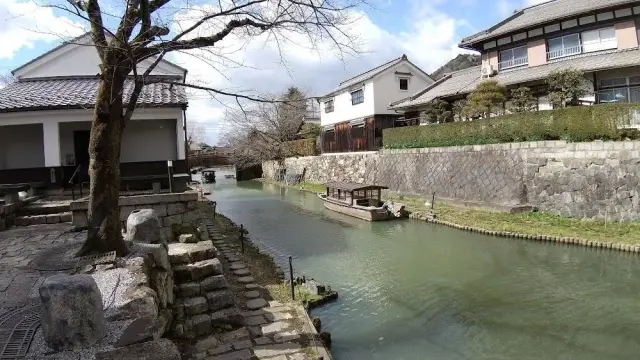https://www.dekitabi.com/itinerary/omihachiman-city-half-day-tour
Nestled in the heart of Japan’s rich cultural landscape, Hachimanbori, Himure Hachimangu Shrine, and Chomeiji Temple offer a unique glimpse into the nation’s storied past and serene beauty. Each location holds its own distinct allure, providing travelers with unforgettable experiences rooted in tradition and history.
Hachimanbori: A Glimpse into Japan’s Historical Canals

https://www.dekitabi.com/attraction/hachiman-bori
Hachimanbori, an elegant canal system located in the city of Omihachiman, Shiga Prefecture, stands as a testament to Japan’s historical ingenuity. Originally constructed during the Edo period (1603-1868), this picturesque canal was an essential waterway for transporting goods, particularly from the bustling merchants’ district to the nearby lakes and beyond.
The Charm of Hachimanbori
Hachimanbori’s charm lies in its well-preserved state, offering visitors a rare opportunity to experience a slice of Japan’s past. The canal is flanked by traditional machiya (townhouses) with wooden facades that evoke a bygone era. Walking along the canal, you’ll find picturesque views of the old warehouses and merchant homes, which have been converted into quaint shops and cafes. The tranquil ambiance is perfect for leisurely strolls, allowing you to soak in the historical atmosphere and enjoy the scenic beauty.
Cultural Significance
Hachimanbori is not just a visual delight; it also holds cultural significance. The canal system was designed to facilitate trade and transport, contributing to the prosperity of the region. Its preservation as a historical site underscores Japan’s commitment to maintaining its cultural heritage. The canal serves as a living museum, illustrating the sophisticated water management techniques used during the Edo period.
Himure Hachimangu Shrine: A Sanctuary of Spiritual Serenity

https://www.dekitabi.com/attraction/himure-hachimangu
Situated in Omihachiman, Himure Hachimangu Shrine is a prominent Shinto shrine dedicated to Hachiman, the god of war and agriculture. Founded in the 9th century, this ancient shrine holds a deep spiritual significance and is an important pilgrimage site for those seeking blessings and peace.
Architectural Beauty
The shrine’s architecture is a splendid example of traditional Shinto design. The main hall, or honden, is characterized by its elegant wooden structure and intricate carvings. The serene atmosphere is accentuated by the surrounding lush greenery and the peaceful sounds of nature. The approach to the shrine, lined with towering torii gates and stone lanterns, creates a sense of reverence and anticipation.
Festivals and Events
Himure Hachimangu Shrine is known for its vibrant festivals, which draw visitors from across Japan. The annual Hachimangu Matsuri, held in September, is a lively celebration featuring traditional performances, processions, and ceremonies. This festival provides a unique opportunity to experience local culture and traditions in an immersive setting.
Chomeiji Temple: A Haven of Tranquility and Tradition

https://www.dekitabi.com/attraction/chomeiji-temple-shiga
Chomeiji Temple, located in the scenic mountains of Shiga Prefecture, is a Buddhist temple renowned for its tranquil environment and historical significance. Established in the 9th century, Chomeiji Temple is part of the Saigoku Kannon Pilgrimage, a revered route featuring 33 temples dedicated to the goddess Kannon.
Scenic Beauty and Spiritual Experience
The temple’s location amidst verdant hills and ancient forests enhances its serene atmosphere. The temple grounds feature beautifully landscaped gardens, stone pathways, and traditional buildings that invite contemplation and reflection. The main hall, or hondo, houses a revered statue of Kannon, believed to offer protection and compassion to those who seek solace.
Cultural and Spiritual Significance
Chomeiji Temple is not only a place of worship but also a cultural treasure. The temple’s architecture and art reflect the rich history of Japanese Buddhism, offering insights into the spiritual practices and artistic traditions of the time. Visitors can participate in meditation sessions and rituals, gaining a deeper understanding of Buddhist teachings and practices.
Planning Your Visit
When planning a visit to Hachimanbori, Himure Hachimangu Shrine, and Chomeiji Temple, consider the following tips to enhance your experience:
- Best Time to Visit: Spring and autumn are ideal times to visit these sites, as the weather is pleasant and the natural surroundings are particularly beautiful. Cherry blossoms in spring and vibrant foliage in autumn provide stunning backdrops for your exploration.
- What to Bring: Comfortable walking shoes are essential for exploring Hachimanbori’s canal system and the temple grounds. If you plan to participate in religious ceremonies or rituals, dress modestly and respectfully.
- Local Cuisine: Don’t miss the opportunity to sample local delicacies at nearby eateries. Omihachiman is known for its traditional Japanese cuisine, including fresh seafood and regional specialties.
- Respect Local Customs: When visiting Himure Hachimangu Shrine and Chomeiji Temple, be mindful of local customs and practices. Show respect by following proper etiquette, such as washing your hands at the purification fountain and refraining from taking photos in restricted areas.
Conclusion
Hachimanbori, Himure Hachimangu Shrine, and Chomeiji Temple offer a rich tapestry of Japanese history, culture, and spirituality. Whether you’re captivated by the historical charm of Hachimanbori’s canals, the spiritual serenity of Himure Hachimangu Shrine, or the tranquil beauty of Chomeiji Temple, these sites provide a unique and enriching experience. Embark on a journey to discover the profound heritage and timeless elegance of these remarkable locations.


Leave a Reply